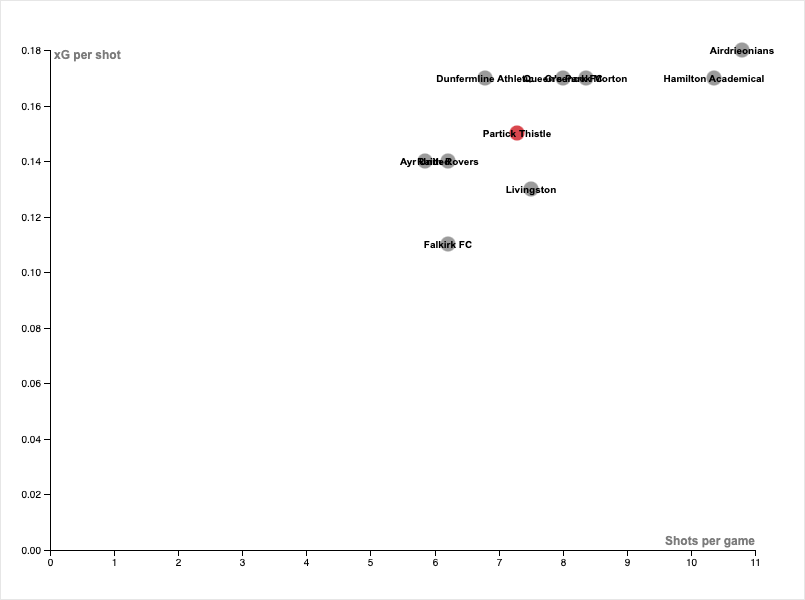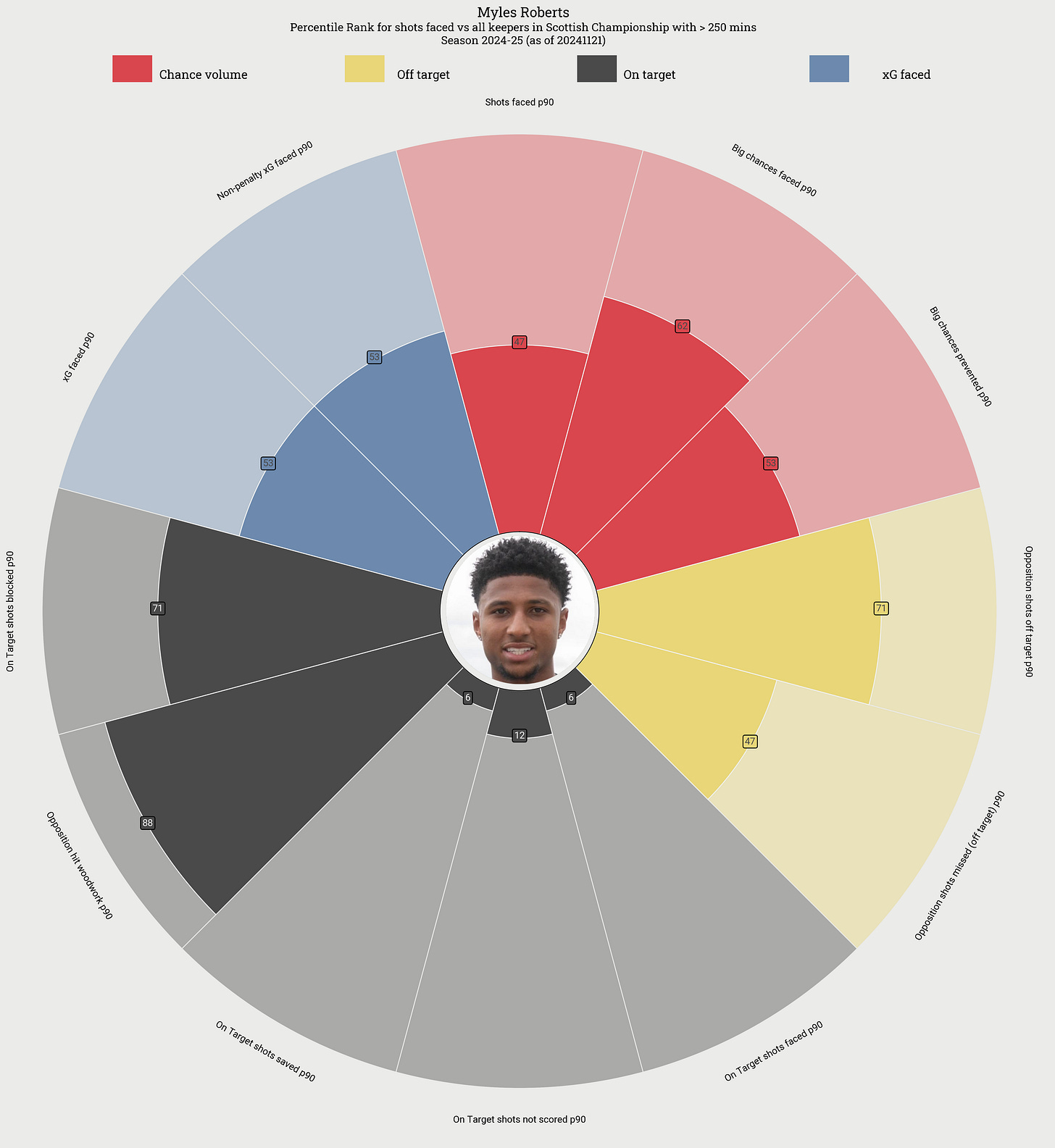TL;DR - Myles Roberts is good at taking the game to defenders proactively and that’s saved Thistle a many-lots of goals this season.
I mentioned a couple of weeks ago that Thistle has one of the best defensive units in the country - at the time, only a few elite teams in Scotland and England were better than Thistle and Falkirk at keeping the ball out.
The defenders are a big part of that - our default back four are doing a great job at winning the ball and doing core defensive things really well.

Thistle give up about the same number of shots as Livi per game but generally the shots we give away are a slightly higher quality than Livi, Ayr or Raith Rovers. And we give up on average 1-2 more shots a game than Falkirk, and the shots are an average of 0.15 xG compared to Falkirk’s 0.11 (in other words, an average striker would score one in every six shots we give up, compared to about 1 in 10 for Falkirk).
And yet, Falkirk and Thistle give up the same number of goals, more or less.
And Raith Rovers give up WAY more than both of us.
All of which leads to my two questions this week:
Why? Why is Thistle equivalent (defensively) to the league leader despite giving away more and clearer-cut chances, and
Why are Raith Rovers not on par with the other playoff chasers, especially given how well they did last season*?
The answer to the first of these is simple (and we’ll come to the second in time).
Myles Roberts.
The Man, The Myth, the Myles
Myles Roberts is immense. Over the course of the first 14 games this season, Myles has played pretty much every minute (only Dabrowski at Raith and Hogarth at Falkirk have done that elsewhere). And when you add up the xG he’s faced, Roberts should have conceded 6.51 more goals than he has.
Hogarth at Falkirk has conceded more or less exactly what you’d expect given the shots he’s faced. His defence seems to play as much of a role in their record as Hogarth.
And Kevin Dabrowski (who was pretty special last year when Raith were making a run at the league) has conceded 6.2 more than you’d expect. Which is, as they say on Wall Street, sub-optimal.
There’s the punchline to the first question.
Because of Myles Roberts.
Thistle are between 6 and 7 goals better off than we would have been otherwise. Or about a goal every 2 games. Which is pretty significant.
Glasgow’s Myles Better
(sorry not sorry)
I built a basic clustering model to group players who do similar things well. The idea is that the algorithm looks at loads of metrics (how many passes you make, how much you touch the ball, how many saves you make, and so on) and finds a way of munging that all together into groups of similar players.
The model (which is pretty rough) ends up putting keepers together like this:

Interestingly, Myles gets grouped with Dabrowski - so at some point we’ll have to unpack why they have such different outcomes (given they face similar numbers of shots of similar ish quality). There’s something like a twelve-goal swing if you swap Myles for Dabrowski this season.
They’re joined in their cluster by Ryan Mullen, the Morton keeper who played 6 of the first 8 games before temporarily being replaced by Lewis Budinauckas on loan from Rangers, and then coming back in game 14 (side note - Lewis is the son of former Thistle keeper Kevin Budinauckas, who was the erstwhile a backup to Kenny Arthur back in the late 90s and early 2000s. Small world).
Hogarth and the Ayr keepers grouped together along with Shamal George (who started the first few games in goal for Livi) Budinauckas, and the Dunfermline and Airdrie keepers.
Prior, who took over from George in goal for Livi is in the other main group (which in itself is interesting - George and Prior are different types of keeper), with another Morton fill-in keeper, Dunfermline’s alternate, and the Hamilton and QP keepers.
What type of keeper is Myles, then?
He’s got the characteristics of a ‘spare defender’ or sweeper-keeper.

Core keeping
The core of goalkeeping is how well you claim balls into the box, how well you limit attacking players’ options and how well you save the ball. Myles is slightly above average in terms of how many high balls he claims per game, and rushes out way more than most other keepers (more than twice a game on average, compared to once a game for Hogarth).
Partly because Milne, O’Reilly and Megwa carry forward with the ball, it’s not unusual for there to be a lot of space available behind the defence. Historically, this meant we were open to fast breaks, as well as being very weak on corners and crosses, but Myles is good at restricting those type of chances (he makes a ‘good high claim’ at a rate of 0.6 a game, which is slightly below Dabrowski and Ferry, and quite a bit below Mullen, but well ahead of the likes of Hogarth).
He gets off his line fast both vertically and outwards towards oncoming strikers.
Interestingly, he doesn’t have to make many actual saves which could be a good thing (as he and the defence are limiting chances). But Myles is proactive - he goes at the ball aggressively, and doesn’t let the attacker make the decisions on their own terms.
Distribution
Myles favours longer distribution, rather than short to the back four - which is interesting, given the capability of our defence with ball at feet. About 56% of his passes are longer, compared to Hogarth, who makes around 25% long and the rest short to the defence (Dabrowski is similar to Miles at 57% long). Dunfermline are the other team who tend to go long from the keeper. Which isn’t awesome company to keep in terms of league position. At the moment, Myles’ success rate isn’t great - he’s at the lower end of the league in terms of pass success rate both short and long. If there’s a weakness, this might be it.
Sweeping
Duels
Where Myles really comes into his own is when he’s doing things traditionally done by defenders. It really shows that he’s been trained at an academy in England at a high youth level, encouraging goalkeepers to press the attack and act more like a sweeper (though Watford are not necessarily known for … stability in their backroom).
He’s in the top 15% of league keepers for how often he comes out of 50-50 clashes winning the ball, and is comfortably top half for how many times he tries this per game. He wins a 50/50 about 0.7 times a game and almost never loses them. Prior at Livi, Mullen (Morton) and Callum Ferrie (QP) are the only ones who win more and Ferrie and Prior both lose some too which is a bit risky (side note - longer term, Mullen is probably worth a look as a long term backup as he profiles quite favourably with what Myles is good at).
Traditional Defending
And even more striking is the fact that Myles gets involved in traditional defensive actions - he intercepts the ball, cutting out through balls and nascent attacks in the top 10% (1.7 times a game) and clears the ball out of the box in the top 25% (which probably contributes to his long ball bias and lower success rate passing - he’s making long balls that are more about clearing out than setting up). Overall, he’s in the top two for defensive actions (2.4 a game - only Ayr’s Liam Russell is comparable).
Bonus: Shots faced
It’s worth mentioning that Myles’ activity then influences the types of shots that he faces. Rushing out more, intercepting and pressuring attackers more, means that they might get high xG chances (good shot location, on a strong foot, limited defenders in the way), but they don’t have the time to use them well. He faces slightly more than normal ‘big chances’ (SofaScore determines these as the sort of chances that a striker really should score - through on goal, one on one, limited opposition and so on), which is related to the fact that Thistle’s attack-minded defenders do leave a bit of space. Rushing out more means he gets into more 1-on-1s.
But he does that so well that the opposition end up with a lot of blocked shots (a Thistle player getting in the way) and shots going wide, or hitting the woodwork.
Comparing Myles to other keepers
If we compare Myles to a few other league goalkeepers, you can see some of the difference.
Type 1 - Protected and pinned to the line
Nicky Hogarth at Falkirk gets much less involved in the game. His blue and red sections are much shorter - he’s protected from the ball more by his defence, and is less proactive off his line. He passes well and generally short, and rushes out a lot less. It’s hard to tell how good a keeper he is from this because most of the work by Falkirk defensively seems to be done by the line in front of him.
Type 2 - Aerially dominant Sweeper keeper

Dabrowski, on the other hand, looks more like Myles - he’s much more likely to rush out, get involved in duels and defensive actions, makes a lot of high claims, and passes long. It’s interesting that he’s so similar in that profile (this is really what the clustering picked up on), and yet the outcomes are different.
He’s a bit less successful than Myles at actually getting in blocks, interceptions and so on when he rushes out - so he concedes more goals. That seems to be the big difference.
If you’re going to rush out a lot, you have to be elite at forcing the attack to lose the ball or miss the shot.
Rushing + high defensive output - great overall goalkeeper record.
Rushing + mid defensive output - really scary-bad record.
Type 3 - Build-up and tackle
The third typology is the player who rushes out, but only to tackle and not to do other defensive things. This type of keeper passes more and is involved in build-up play. Prior at Livi is a good example - he’s super involved in what his team is doing, and passes a lot compared to the other types (Prior attempts 29 passes and makes 26 successfully per game compared to Myles’ 21 and 15) but doesn’t do the variety of defensive things that, say, Myles does.
Don’t do it…
There’s more to say about this - I think figuring out exactly what Myles does to strikers that puts them off would be interesting to investigate, as would the change in Dabrowski from last year to this. I believe it’s the combination of proactivity and commitment to the defensive action (and not just hoping size will intimidate as you run out).
But right now, my main concern is that I’m trying really, really hard not to fall in love with this particular loan player.
*sidebar: I think there’s something in a ‘first season charge’ - QP, Raith and Falkirk have all done that in their first season post-promotion, and then not managed to follow through, and tailed off from season 2 onwards. Thistle on the other hand have hit very similar outcomes every season since promotion from league 1. It’s worth thinking about. But not today.







